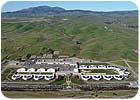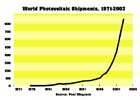
The green roofing in the coming years might just be made of silicon. The market for solar energy is about as perfect as this world can create, and solar applications are on the radar screens of many roofing contractors. For many contractors, the way to greener pastures is to be the one-stop solution for rooftop needs. Reflectivity, gardens, insulation and recycling are all great ideas that can be ruined by a leak, so it's only natural that the roofing expert takes on these tasks.
"If you've got to pierce that roof, you've got to have someone who's going to guarantee it's not going to leak," says Dan Whigham, owner of SC Solar in Lancaster, S.C. "Every job we have to contact the roofing contractor."

A New Dawn?
If the moment has arrived, it's not like any that was predicted for solar roofing. Demand for photovoltaic (PV) cells that generate electricity is so enormous that there is a worldwide shortage. The economy of scale that was supposed to lower prices has been eaten up by those taking advantage of incentives simply too good to pass up. While the U.S. space program was a pioneer in PVs, this country lags far behind Europe and Asia in capitalizing on their enormous potential. Energy prices are soaring as everyone struggles to calculate the benefits of purchasing a little piece of the sun.The Energy Policy Act of 2005 signed by President Bush last year offers tax credits for solar energy beginning Jan. 1, 2006 (including PV cells and domestic hot water heating). Homeowners get a 30 percent tax credit to reduce their tax bill by up to $2,000; businesses get the same 30 percent credit with no limit. Tack on credits offered by states like North Carolina (35 percent) and California (10 percent), and solar energy is a gift to anyone with a calculator. In fact, so many are seeing the light that double-digit growth in production still can't keep up.
"Capacity is being added, but the problem is, so are installations," says Whigham, who is managing a healthy inventory of PV cells right now. "We're not having a bottleneck. We have a purchasing power that other competitors don't have. Cash is king."
Still, he expects to be sold out by July. The surge in demand caused some of his suppliers to increase their prices seven times last year. If distributors can't take on new customers, those hoping to get in on the ground floor may find themselves in the basement for a while. Still, the potential has never been greater.
According to figures assembled by the Earth Policy Institute, worldwide production of solar cells grew 32 percent in 2003, the latest year for which figures are available. There is an estimated worldwide production of over 3,000 megawatts - enough energy to meet the electrical needs of one million homes. Government incentives and market introductions were credited with an explosive growth in production that is reminiscent of the Internet boom. The difference real products are manufactured for real profits. Roughly half of the PV cells made come from Japan, which has invested heavily in incentives that paid for half of installation costs; the subsidy is now 10 percent due to lower costs. Countries like Germany - the second largest producer of PV cells - have exceeded their goals for installations by providing low-interest loans, fostering domestic PV production and mandating rates for those selling excess electricity back into the grid.
The United States presents a different picture. Production actually fell in 2003 due to a restructuring and bankruptcy. The Million Solar Roof Initiative - a national program launched in 1997 by President Clinton - has stalled in its effort to meet its goal of one million roofs with PV cells by 2010. On the other hand, California Public Utilities Commission passed it's own Million Solar Roofs initiative in January, and will provide $2.9 billion in subsidies over the next ten years. As solar energy comes to a bid near you, Whigham believes that the time is ripe for roofing contractors to exploit this opportunity.
"It would be advisable to start an alliance with a solar contractor. You're going to have to have an electrician and roofing contractor on every job," he says. "This isn't for hippies anymore. You don't have to be a tree hugger to see the money in this."
Sharp, the world's largest integrated producer of PV cells whose parent company recorded $24.2 billion in sales for 2004, made more money from its solar division than from its famed electronics division last year. The company that began as a sheet metal shop has PV production facilities in Japan, the United Kingdom and the United States. Some Lowe's Home Improvement centers in California deploy contractors to install solar systems, a sure sign of market feasibility.
PowerLight Corp. of Berkeley, Calif., sells solar arrays for commercial installations and works with production builders of residential housing. The company recently installed the largest array of PV cells in the American West, a 1.12-megawatt station on the roof of Santa Rita Jail in Alameda County, California. The company has a proprietary system that doesn't penetrate the roof and even provides added insulation. Installers are generally electricians, but that's not required. The company has in-house training, and a project manager is available to maintain quality assurance.
Susan DeVico, spokesperson for Power-Light, expects to have several large installations come on-line this year, including a community in Simona that will be 100 percent solar generated. The company recently announced a $330 million agreement with its solar supplier, SunPower Corp. While the average cost for electricity generated may not be competitive yet, reducing peak loads makes these systems feasible when the sun is hottest.
"That's when the solar is working most efficiently and it happens to coincide with the highest utility rates," says DeVico. "It's a big factor."

Bright Idea
Greg Watson has been roofing since 1972, and he incorporated Watson Services in 1978. With offices in Sacramento and Los Angeles, he's ridden many waves in the turbulent California economy and has been dabbling in solar energy for about a year. His current project on the massive Long Beach Convention Center calls for a total of 6,000 squares of reroofing and 1 megawatt of power generation. The combined installation of roofing and solar arrays is tightly linked as building owners look for long-term roofing solutions when they're purchasing equipment expected to be in place for decades."It's starting to pick up, and we're bidding several projects right now," says Watson. "It's really so new that we're just starting to sell it. We don't even have it on our Web site."
Instead of the nightmare projects when holes made by somebody else have to be fixed immediately, the roofing contractor is part of the design and specification phase as well as the one who fabricates, installs and seals the penetrations. Even reflectivity is important as building owners look to reduce heat loads or meet government mandates. For the current phase of 2,200 squares, Watson is installing a fleece-backed Cooley 60-mil single ply adhered with hot asphalt.
"You've got to put in a system that's going to last 25years," Watson explains. "[The solar array] goes hand in hand with the roof." Another job Watson installed with a solar array called for four plies of modified base sheets from Malarkey with an aluminum surface, the kind of "bombproof" roofing that any contractor would be happy to bid, install and stand behind. It seems that the customers who go solar understand that cheap roofs can make their expensive investment go down the drain. Watson was able to shift quickly into the solar business due to his general contractor's license and several electricians on staff. With a sheet metal shop that fabricates the support structures and a range of roofing solutions, the strictly commercial contractor finds itself at the convergence of extremely favorable factors.
For years, the solar industry was a fringe application that appealed to consumers out of necessity or with a deep regard for the environment. It's easy to get consumers to embrace extra insulation, passive heating or double-paned windows yet a solar hot water heater doesn't even register, despite the fact that one installed today on a home most anywhere in the country can pay for itself in three to five years. Energy Star and reflectivity ratings are examples of how roofs are as integral part of the energy equation on everyone's mind. Even with the incentives, the cost for PV cells to generate electricity still struggle to be competitive in most areas.
Watson hasn't seen any demand for solar water heating from his business base, but his phone is ringing because the economics of PV cells on the roof are so favorable in California right now. When clients look at power shortages, rising utility rates, unlimited tax credits, accelerated depreciation and 80 percent of the debt service being offset by lower electric bills, it becomes a matter of asset allocation. Roofs can now function as a securities instrument offering a superior return on investment - and the financial planner is you.
"They're ready to pull the trigger," he says about building owners. "Our focus is roofing. If we can get a piece of the solar action, we'll do it."
Report Abusive Comment